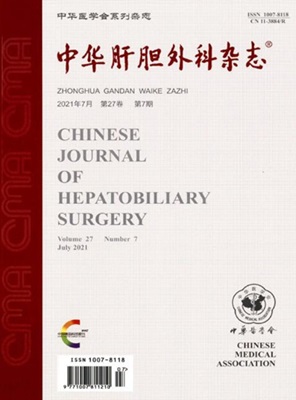腹腔镜胰十二指肠切除术:单中心102例报告
Q4 Medicine
引用次数: 0
摘要
目的总结单中心腹腔镜胰十二指肠切除术的技术要点。方法回顾性分析河北医科大学第二医院肝胆外科2018年行腹腔镜胰十二指肠切除术的102例患者的临床资料,分析其一般情况、手术时间、术中出血量及手术操作情况。观察术后并发症、住院时间等指标。结果102例患者中,男性57例,女性45例,年龄15.0 ~ 79.0(59.9±11.8)岁,体重指数(23.6±3.6)kg/m2。102例行LPD的患者中,6例行全胰腺切除术。其中三种以门静脉-肠系膜上静脉节段切除术的形式联合血管切除术。手术时间(376.6±87.2)min,术中出血量350 (100,800)ml,术后住院时间(17.0±5.9)d。102例患者中出现术后并发症26例(25.5%),2例以上并发症17例。B/C级胰瘘9例(9.4%),腹部出血8例(7.8%),胃肠道出血2例(2.0%),胆道瘘4例(3.9%),胃排空障碍5例(4.9%),肺部感染8例(7.8%)。围手术期死亡5例(4.9%)。结论LPD的主要技术要点包括整体切除、胰空肠吻合术和血管重建。LPD的基础是整体切除。血管段联合切除重建是LPD技术成熟的标志,也是作为常规手术进一步发展的前提。关键词:腹腔镜;胰十二指肠;Monolithectomy;联合血管切除和重建本文章由计算机程序翻译,如有差异,请以英文原文为准。
Laparoscopic pancreaticoduodenectomy: a report of 102 patients in one single center
Objective
To summarize the technical points of laparoscopic pancreaticoduodenectomy (LPD) carried out in a single center.
Methods
The clinical data of 102 patients who underwent laparoscopic pancreaticoduodenectomy in 2018 at the Department of Hepatobiliary Surgery of the Second Hospital of Hebei Medical University were retrospectively analyzed, and the general conditions, operation time, intraoperative blood loss, and surgical operation were analyzed. Post-operative complications, hospital stay and other indicators were studied.
Results
Of the 102 patients who were included, there were 57 males and 45 females, aged 15.0 to 79.0 (59.9±11.8) years old, with a body mass index (23.6±3.6) kg/m2. For the 102 patients who underwent LPD, 6 were total pancreatic resection. Three were combined with vascular resection in the form of portal vein-superior mesentery vein segmental resection. The operation time was (376.6±87.2) min, the intraoperative blood loss was 350 (100, 800) ml, and the postoperative hospital stay was (17.0±5.9) days. Postoperative complications occurred in 26 of the 102 patients (25.5%), and more than two complications occurred in 17 patients. B/C grade pancreatic fistula occurred in 9 patients (9.4%), abdominal bleeding in 8 patients (7.8%), gastrointestinal bleeding in 2 patients (2.0%), biliary fistula in 4 patients (3.9%), and gastric emptying disorder in 5 patients (4.9%), 8 patients had pulmonary infection (7.8%). Five patients (4.9%) died during the perioperative period.
Conclusion
The main technical points of LPD included en bloc resection, pancreaticojejunostomy, and vascular reconstruction. The basis of LPD is en bloc resection. Combined resection and reconstruction of vascular segments is a sign of maturity of LPD technology and a prerequisite for further development as a routine procedure.
Key words:
Laparoscopy; Pancreaticoduodenectomy; Monolithectomy; Combined vascular resection and reconstruction
求助全文
通过发布文献求助,成功后即可免费获取论文全文。
去求助
来源期刊

中华肝胆外科杂志
Medicine-Gastroenterology
CiteScore
0.20
自引率
0.00%
发文量
7101
期刊介绍:
Chinese Journal of Hepatobiliary Surgery is an academic journal organized by the Chinese Medical Association and supervised by the China Association for Science and Technology, founded in 1995. The journal has the following columns: review, hot spotlight, academic thinking, thesis, experimental research, short thesis, case report, synthesis, etc. The journal has been recognized by Beida Journal (Chinese Journal of Humanities and Social Sciences).
Chinese Journal of Hepatobiliary Surgery has been included in famous databases such as Peking University Journal (Chinese Journal of Humanities and Social Sciences), CSCD Source Journals of China Science Citation Database (with Extended Version) and so on, and it is one of the national key academic journals under the supervision of China Association for Science and Technology.
 求助内容:
求助内容: 应助结果提醒方式:
应助结果提醒方式:


